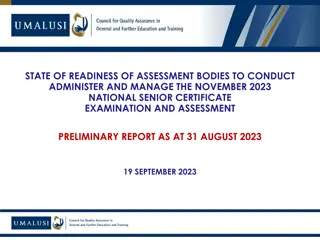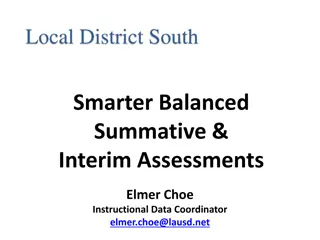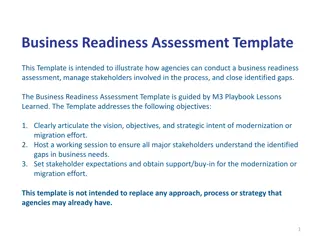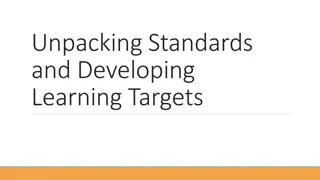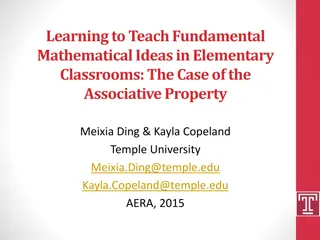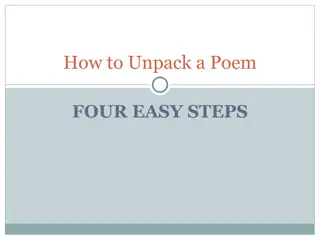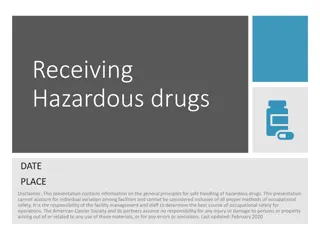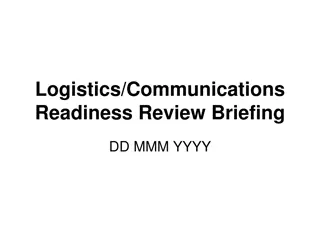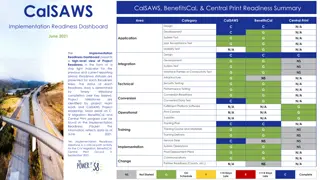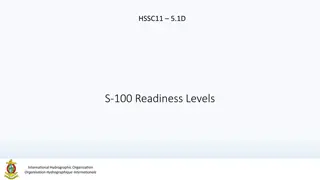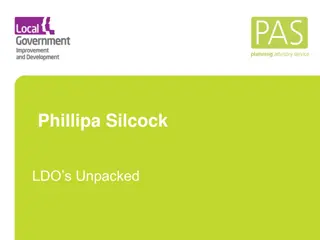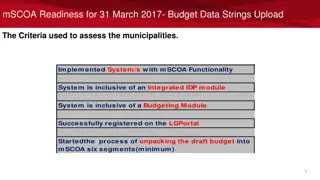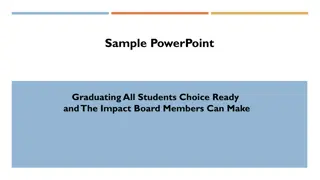Unpacking the Illinois Assessment of Readiness (IAR) Results for Instructional Enhancement
This informative content discusses a workshop aimed at helping district/school teams analyze IAR results to identify trends, enhance instructional practices, and plan for student improvement. Key topics include workshop goals, resources, and the purpose and intended uses of the IAR results.
Download Presentation

Please find below an Image/Link to download the presentation.
The content on the website is provided AS IS for your information and personal use only. It may not be sold, licensed, or shared on other websites without obtaining consent from the author.If you encounter any issues during the download, it is possible that the publisher has removed the file from their server.
You are allowed to download the files provided on this website for personal or commercial use, subject to the condition that they are used lawfully. All files are the property of their respective owners.
The content on the website is provided AS IS for your information and personal use only. It may not be sold, licensed, or shared on other websites without obtaining consent from the author.
E N D
Presentation Transcript
Unpacking the Illinois Assessment of Readiness (IAR) Results to Inform Instructional Practices 1
Workshop Topics Getting focused Results of informational survey Intended uses of the IAR Resources available to support Suggested unpacking protocol Reflection and planning for next steps The workshop is intended to be flexible to support district/school teams as they work with their results. 2
Workshop Goals Participants will: identify patterns and trends in student achievement based on their district/school results; unpack those patterns/trends to identify one or two areas to investigate further; reflect on instructional practices provided to students; and begin to translate those insights into next steps. 3
First Things First School is about teaching and learning Assessment informs teaching and learning 4
Teaching & Learning Knowledge and skill are not bound by a single standard or a grade level Expertise draws from a wide range of knowledge and skills 5
What must a student know to answer this question? 6
Purpose and Intended Uses of the IAR 7
Purpose of the IAR The primary purpose of the IAR is to: measure what students know and can do in ELA and mathematics; and assist educators in supporting student learning, inform accountability, and provide information on college and career readiness. 8
Intended Uses of the IAR Results The intended uses of the IAR results include: Summarizing student achievement; Describing student performance relative to meeting standards; and Supporting improvement planning (e.g., prioritizing professional learning and resource decisions, advising program alignment with academic standards, reflecting on the effectiveness of school initiatives). 9
Purpose and Intended Uses of the IAR Results Because the IAR is a summative assessment, which occurs at the end of the school year: The results are meant to provide a snapshot of how well students have mastered the standards, illuminate trends in student achievement, and therefore inform future instructional efforts. The summary/group (school and district) reports will provide the richest information. 10
Resources to Support Interpretation of the IAR 11
Resources to Support the Interpretation of the IAR Results There are several resources available to help educators understand and interpret IAR results: Illinois Learning Standards Evidence Statements Blueprints ELA/Literacy Writing Rubrics Performance Level Descriptors ELA/Literacy Task Models Mathematical Task Types Digital Item Library Released Items IAR Score Interpretation Guide IAR Performance Level Cut Scores These documents are posted on the IAR website. To locate the specific documents, scroll down to the Test Information and Resources tab on the linked webpage. Additional resources are also available on ISBE s Assessment Literacy webpage. 12
Key Resources to Support Interpretation Evidence Statements: Unpack the content standards to further illuminate the knowledge and skills students are expected to master. Evidence statements guide item and task development and are developed to clarify what mastery of a standard/set of standards looks like they describe the knowledge and skills an assessment item or task should elicit from a student based on the ILS. Some standards may have multiple evidence statements. Some evidence statements may draw from multiple standards (e.g., the INT (integrated) standards in mathematics). 13
Understanding the Evidence Statements Evidence statements are derived from the ILS. Evidence statements provide a description of the competencies and knowledge that students are expected to achieve based on the standards. The items on the IAR are designed to elicit the evidence of understanding described in these statements. The evidence statements should not replace the ILS; rather, they can serve as a companion resource to augment understanding of the expectations within the standards. 14
Understanding the Evidence Statements The Evidence Statements are organized by grade level and claim. ELA/L Claims Mathematics Claims Reading Literature Reading Information Vocabulary Interpretation & Use Written Expression Knowledge of Language & Conventions Major Content Additional & Supporting Content Mathematical Reasoning Mathematical Modeling 15
ELA/L Evidence Statements A standard could have a single or multiple evidence statements. 16
Mathematics Evidence Statements Corresponding Mathematical Practices (MP) identify the essential skills students should develop in order to become proficient in mathematics and can be found in the Illinois Learning Standards for mathematics. Content limits and clarifications are provided when applicable. Subclaim Key: A: Major Content B. Additional and Supporting Content C: Mathematical Reasoning D: Mathematical Modeling Integrated evidence statements (Int) include content/skills derived from multiple grade- level standards. Integrated evidence statements are denoted with INT (i.e., 5.Int.1). 17
Understanding the PLDs Provide meaning to the student s scale score. Describe the knowledge and skills students in each performance level typically demonstrate. They represent the progression of understanding, thinking, and reasoning in each content area. 18
Understanding the ELA/L PLDs The ELA/L PLDs are organized by Reading and Writing. Text complexity, range of accuracy, and quality of evidence are key features that increase in sophistication across the performance levels. Use of the PLDs should consider the focus area of the standards: Key Ideas & Details Vocabulary Acquisition and Use Craft and Structure Integration of Knowledge & Skills Knowledge of Language and Conventions Written Expression 19
Understanding the Mathematics PLDs The Mathematics PLDs are organized by claim (e.g., Major Content) and concept (e.g., Operations with Fractions). The evidence statements associated with each concept are included. 20
Key Resources to Support Interpretation Resources to Inform Curriculum and Instruction: ILS Evidence Statements These resources outline what IL wants students to know and do and as such, inform scope and sequence. Resources to Inform Instruction and Assessment: Evidence Statements PLDs Task Models Released Items, Rubrics, Student Exemplars These resources help inform how much students should know and do; as such, they can inform the design of instructional tasks and activities as well as calibrate expectations. 21
IAR Blueprints The test blueprints communicate the overall design specifications for each grade and content area test. There are two types of blueprints for the IAR: 1. Structural detail the number of points by item type for each claim and section of the test; and 2. Content detail the percentage of questions that contribute to each claim and list the eligible standards and evidence statements to be assessed by strand/domain. Note: For ELA/L there are two blueprints as two forms are administered - one for the Literary Analysis Task form and another for the Narrative Writing Task form. Students only take one form. Both forms are administered in each classroom. 22
ELA/L Content Blueprint Grade 5 LAT Note that there is also a blueprint for the NWT form for each grade. 23
Mathematics Content Blueprint Grade 7 24
IAR Score Reports School Level Reports Score Report Intended Audience Description Provides detailed information about a student s performance on the IAR, including their scale score, performance level, and subclaim readiness estimates. The report also includes the student s growth percentile and the predicted Lexile and Quantile scores. Students Parents Teachers Individual Student Report (ISR) Summarizes the achievement of each student who took the content area assessment, along with their overall scale score, performance level, and subclaim readiness estimates. The state, district, and school results are provided for comparison. Teachers School Administrators School Student Roster Displays the average scale score for the state, district, and school, as well as the number and percentage of students who achieved each performance level. Disaggregates the school s data by gender, ethnicity/race, economic, disability, English learner, and migrant status. School Performance Level Summary School Leadership Teams District Administrators School Evidence Statement Analysis School Leadership Teams District Administrators Summarizes the average percent correct for the assessed Evidence Statement, in order of difficulty, at state, district, and school levels. 26
IAR Score Reports District Level Reports Score Report Intended Audience Description Displays the average scale score for the state and district, as well as the number and percentage of students who achieved each performance level. Disaggregates the district s data by gender, ethnicity/race, economic, disability, English learner, and migrant status. District Performance Level Summary District Administrators Displays the percent of students achieving each performance level for the state, district, and each school in the district. Includes the average scale scores achieved and the percent of students at each readiness level by subclaim. District Summary of Schools District Administrators Summarizes the average percent correct for the assessed Evidence Statement, in order of difficulty, at state and district levels. District Evidence Statement Analysis District Administrators Summarizes the percentage of points earned by each student in the district on the operational items. Organized by the ILS strand/domain and includes the average percent of points earned by all students across the state for comparison. School Content Standards Roster District Administrators 27
Types of Scores Type of Score Definition Scale scores are standardized scores that account for the difficulty of the items on a test form. This allows comparisons to be made for the same grade and content area, regardless of test form taken or the year in which a student takes the test (e.g., 2022 vs 2023). IAR scale scores range from 650 to 850 for both ELA/L and Mathematics. Scale scores are also reported for Reading (10 to 90) and Writing (10 to 60). Scale Score Classifications based on the scale score. Performance levels provide meaning to the scale score. Each level indicates what a typical student should know and be able to do based on their command of the grade-level standards. Students achieving a lower performance level demonstrate less mastery of the grade-level standards than those at the higher performance levels. Performance Level The five IAR Performance Levels are: 5 Exceeded Expectations 4 Met Expectations 3 Approached Expectations 2 Partially Met Expectations 1 Did Not Yet Meet Expectation Classifies student performance for each subclaim relative to the overall performance of students who met or nearly met expectations for the content area (ELA/L or Mathematics). Readiness Indicator The three levels of readiness include: H High M Middle L Low A measure of how much growth or improvement a student has made in a content area, from one year to the next, in comparison to other academically similar students (i.e., those who had similar prior scale scores) from across the state. Growth percentiles range from 1 to 99. A student must have a minimum of two consecutive years of content area scale scores (current and prior year) to calculate an SGP. Student Growth Percentile 28
Unpacking IAR Results There are a few things to keep in mind as you review the IAR results: The IAR is developed so that comparisons across test forms and years are comparable for any given grade level. Each performance level represents a range of student achievement. A student s scale scores can provide insight into the magnitude of student performance within the assigned level. The subclaim performance indicators, also referred to as the readiness indicators, compare the student s performance on the items that measure that subclaim to the performance of students who Met or Exceeded Expectations on the overall test. 30
Suggested Protocol for Unpacking IAR Results Use the score reports to identify areas where students performed well and areas where additional support and resources may be needed. Look for patterns and trends in student performance to help guide interpretation. - Remember, all data send a signal; that signal must be interpreted. - Use other student achievement data sources to triangulate interpretations. Reflect on the instructional opportunities given to students throughout the school year. 31
Suggested Steps to Unpack IAR Results 1. Review the School or District Performance Level Summary Reports. a. Note the distribution across performance levels, for all students and each subgroup. Note areas of success and opportunity. b. 2. Review the Student or School Roster. a. Examine the distribution across the three readiness levels for each claim at the school or district level. Note the claims where a higher proportion of students are green or blue. Note the claims where a higher proportion of students are red. Select a claim to examine more deeply. b. c. d. Look at previous years reports, for the grade level of focus, to discern if a trend exists. 32
Suggested Steps to Unpack IAR Results 3. Review the School or District Evidence Statement Analysis Report. a. For successes, note the evidence statements on which students performed well. Given this report is in order of difficulty, these will be on the right-hand side. b. For areas of opportunity, note the evidence statements on which students performed less well. These will be on the left-hand side. It is important to consider the student count for each evidence statement identified. The student count, by evidence statement, can be found beginning on page 2 and represents the number of students who had items aligned to those evidence statements. Use caution when the numbers are low. Focus on those evidence statements with high student counts. 33
Suggested Steps to Unpack IAR Results 4. Reflect on the instructional opportunities provided to students for the identified evidence statement and the associated standards. a. When was the standard taught? b. What were the assignments and tasks students were asked to complete? Use the PLDs and the released items, rubrics, and student exemplars to review those assignments and tasks. Are the expectations calibrated? What worked? What didn t? 34
Suggested Steps to Unpack IAR Results 5. Look across two to three years and across grade levels within the school or district. a. Determine if a trend exists for evidence statements for the same or similar concepts or skills. b. Consider other information about student performance. 35
Suggested Steps to Unpack IAR Results 6. Decide what adjustments in instructional opportunities may be needed for future students and develop a plan for implementation. 36
All reports have been redacted to protect the identity of the students, school, and district. 38
Unpacking Steps in ActionStep 1 School Performance Summary 39
All reports have been redacted to protect the identity of the students, school, and district. 40
Unpacking Steps in ActionStep 2 Student Roster 41
All reports have been redacted to protect the identity of the students, school, and district. 42
Unpacking Steps in ActionStep 3 School Evidence Statement Analysis 43
Unpacking Steps in ActionStep 3 School Evidence Statement Analysis RI 5.7.1: Provides an answer to a question or solution to a problem that draws on information from multiple print or digital sources. RI 5.9.1: Provides a statement that integrates information from several texts on the same topic. RI 5.2.3: Provides a summary of the text. 44
Unpacking Steps in ActionStep 3 School Evidence Statement Analysis Performance in Written Expression is low for the school, as is Knowledge of Language and Conventions. Of the three opportunities to write, student performance was somewhat stronger on the Narrative Writing Task than on the Literary Analysis Task. Student performance on the Research Simulation Task, taken by all students in the grade, was on the weaker side. Perhaps an area to investigate further is the Research Simulation Task (RST). 45
Unpacking Steps in ActionStep 3 In reviewing the Evidence Statement Analysis, I note additional evidence statements related to the prose constructed response (PCR) with a high student count. These include: RI 5.3.3: Provides an explanation of the relationships or interactions between two or more ideas or concepts in a historical, scientific, or technical text. RI 5.1.1: Demonstrates the ability to quote from a text when explaining what the text says explicitly and/or when explaining inferences drawn from the text. Other related evidence statements include: RI 5.6.2: Provides an analysis of multiple accounts of the same topic, noting important similarities and/or differences in the point of view they represent. RI 5.8.2: Provides an explanation of how an author uses evidence to support particular points in a text. I note that students achieved a higher percent correct on items measuring these evidence statements. 46
Unpacking Steps in ActionStep 4 The Grade 5 Task Models are another resource to guide reflection. Task foci for the Research Simulation Tasks include: - Analyzing the relationship between a series of concepts - Analyzing the role of illustrations - Analyzing multiple accounts - Analyzing author s use of evidence What opportunities were provided to students around the identified evidence statements, including using informational texts to make and support claims? 47
Unpacking Steps in ActionStep 4 Released Grade 5 Research Simulation Tasks, along with PCR student exemplars, can help to unpack the expectations and inform reflection on the instructional activities and assignments provided to students. Reflection: Did my lessons, tasks, and assignments cover the skills associated in the evidence statements, task models, and released items? Were my expectations calibrated to the scored student exemplars? 48
Unpacking Steps in ActionSteps 5 & 6 How did 5th grade students perform in previous years? How did students in grades 3 and 4 perform on the Research Simulation Task and the evidence statements identified for grade 5? What other evidence of student performance in this area is available? Does that evidence support the results? Is it calibrated to a similar expectation? Discuss your findings with your colleagues. Look for trends and examine other sources of evidence. 49
Unpacking Steps in ActionStep 7 What instructional plans and student assignments worked well for students? What tweaks or adjustments in instructional plans and associated tasks/assignments may be of benefit to future grade 5 students based on what I ve learned? Devise a plan of action for the upcoming school year. Think about how you will monitor student learning to ensure students are on-track. The steps are best completed by district, school, and grade-level teams, along with individual reflection. 50




